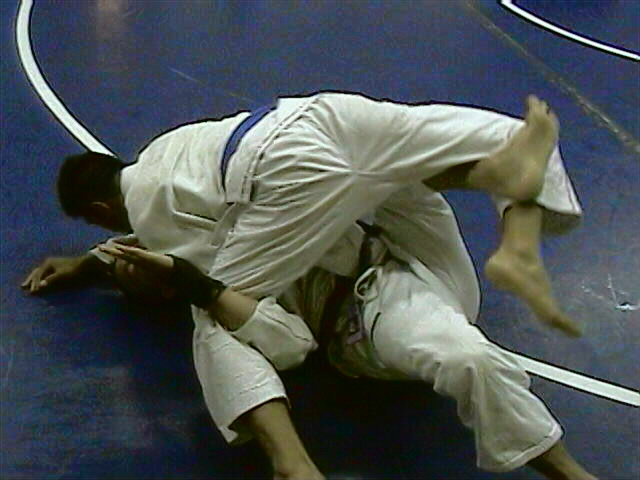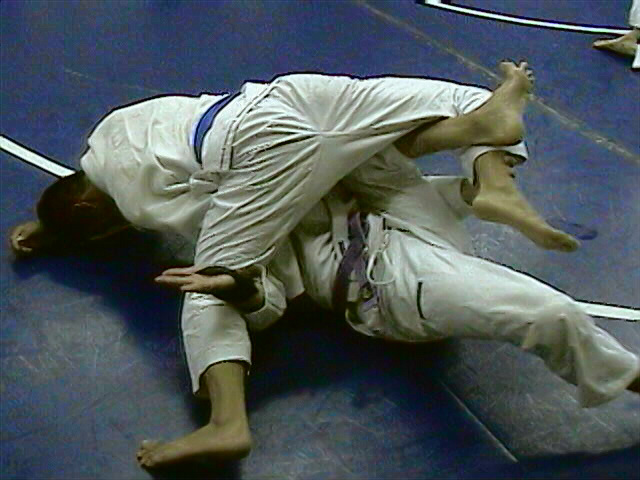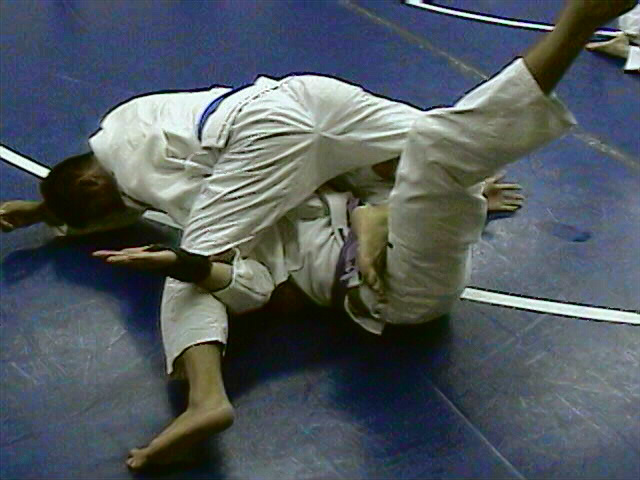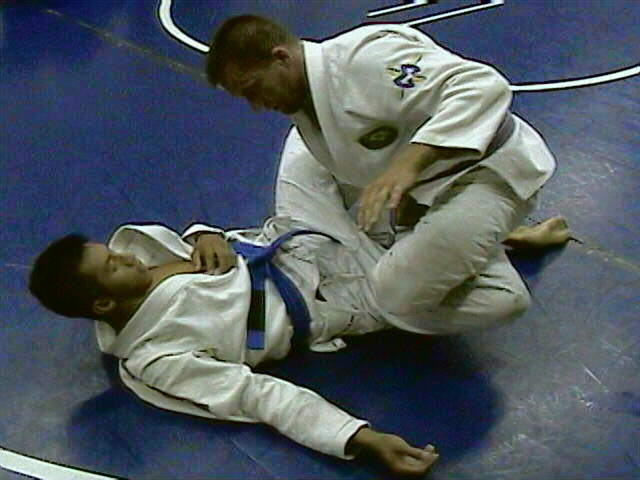Today I want to tell you a story about how I stumbled across a technique by fluke at a tournament, and how it became one of my bread and butter moves from Butterfly Guard, X Guard and Half Guard.
There’s a high-percentage position that I call the ‘Logsplitter’ and I use it all the time. I often end up there by transitioning from Butterfly Guard, X Guard and/or Half Guard. The Logsplitter offers you both sweeping options to get back to the top, and submission options to finish the match right there and then.
But it wasn’t always this way. In fact, the first time I used this position it was a pretty slip-shod affair!
Read on for the full story…
1: I Stumble Upon the Position By Accident
This video is from back in 2002 when I was competing in the Submission Grappling Open Division of the Can-Am Police Fire Games. In this particular match I was battling against a tough and strong wrestler. Nobody had an advantage in points, but I wasn’t happy about having spent most of the match getting ground down with him in my guard.
At a certain point he stood up, and as I tried to get X guard he spun away to escape. I followed his movement, hoping to entangle his legs and work for a leglock, but then he suddenly spun into me and I found myself in unexplored territory.
You see, my right leg was now wedged in between his left calf and hamstring at an odd angle. At first I was worried, because I’d never been in this position before, but the more I thought about it the more I realized that I had an advantage, and even an opportunity to finish the match with a calf compression lock. I started applying the lock, but I was too tentative and my opponent managed to scramble out.
The good news is that I ended up getting a couple of sweep points for this maneuver, and that won me the match and earned me a silver medal in the open division. Whoo-hooo!
2: A Strange Co-Incidence
It was a BIG mistake, but I didn’t give that position any more thought for almost a whole year.
Then, out of the blue, I received an email from someone I didn’t know and had never met. This person was Jeff Rockwell (who teaches at Raptor BJJ in Austin Texas).
Anyway, Jeff wanted to tell me about this strange new position that he’d stumbled across, except that – unlike me – he was setting it up from a failed butterfly sweep. He went into considerable detail and now, with his permission, I’m going to reprint his entire mini-article on what he called ‘the Logsplitter’ (isn’t that an excellent name).
Logsplitter Sweep from Butterfly Guard
by Jeff Rockwell (Raptor BJJ)
I’ve nicknamed this sweep “The Logsplitter”, because if done right, it causes intense pain all over your opponent’s trapped leg, making it feel like it is being split apart with an axe in multiple locations. Though I didn’t invent this sweep (thank you Tony Passos, Pedro Sauer brown belt – he came up with this on his own, and though someone else may be doing it, I’ve never seen it demonstrated by anyone else in a class, seminar, video, or competition).
I have become very fond of it, as it solved the problem of the “reverse butterfly guard sweep” for me. I would often try to sweep my opponents to my right from my butterfly guard – if they blocked it by posting their left leg, I would switch to the reverse BF sweep and try to take them to my left. Unfortunately, I did not have much success with this follow up technique. No matter how much I drilled it, no matter how much I tried to get the timing right, anyone I did not outweigh or out-experience by a great deal simply shifted their weight or posted their other leg, blocked the sweep, and proceeded to pass my guard.
This variation of the reverse butterfly guard sweep, however, solved that issue for me, as it traps the opponent’s leg in such a way that it eliminates both their ability to post, and their ability to sprawl their weight down on top of me. Although the aforementioned inventor of this move is able to use this position as a high percentage submission from the bottom as well, I have not had a great deal of success with it in that manner yet – so I am not going to try to demonstrate it as such until I do. I have had a good bit of success in sweeping white through brown belts with it, however, so I feel I’m qualified to speak on that aspect of it.
Jeff Rockwell

1. In this picture, I am setting up a standard hook sweep from the butterfly guard. I have an underhook on my opponent’s right arm, and an overhook on his left – controlling his left arm at the elbow with my hand and trapping the wrist in my armpit. My head is tight against his, and I am sitting to the side so that my right butt cheek/hip is on the ground.

2. I attempt to sweep him by falling 45 degrees to my right, lifting with my left BF hook and driving on the ground with my right foot. My opponent blocks strongly by raising his left foot and posting it on the ground. There are a number of other ways to follow up and successfully sweep him to the right in spite of this post, but they can be less successful against a skillful player.

3. So I dive to my right, underhooking his left leg deeply with my right arm. My left BF hook remains beneath his right thigh. At this point, I can threaten the traditional reverse BF guard sweep by moving his weight to my left – he will generally counter this immediately by posting his right leg (which is what I want). Or I can simply use my underhook and the lifting power of my left leg to pull his weight over top of me, which will encourage him to post his right leg, or at least make it very light, allowing my right leg to pass underneath it in the following movements.

4. My next step is to bend his right leg and capture it between my left shin and my right thigh. This can be cone entirely with legwork, but it sometimes helps to use for left hand (in this example) to guide his leg into place. In the picture below, you’ll see me reaching for his right shin with my left hand, guiding it to my right. At the same time, I straighten my right leg down to the mat, then move it as far to my left as possible. Though this may seem like a lot of fancy footwork at first, it’s really no more daunting than the movements used in the foot drag/lift mount escapes.
NOTE 1: Just as you use a side-to-side abdominal crunch to place your elbows and hands in the proper position for a foot drag mount escape, the same type of side crunch can be very beneficial when trying to use your hand to guide the leg you are going to trap into position. If you crunch your torso to your left as you raise your opponent’s weight above you, it will be much easier to reach his foot and utilize both your hand and your legs.
NOTE 2: What if he just won’t bend his right leg, you ask? No worries! If you have your left shin in the crook of his right knee, but he straightens his leg and you are unable to pass your right leg underneath it, simply grab his ankle with your left hand and extend your hips so that your left shin drives into the bend of his knee and collapses him backwards. Stephan Kesting refers to this as the “Lumberjack Sweep”, and his Dynamic Guard video does a great job of detailing that. If the opponent defends the lumberjack by shifting his weight forward, he comes right back into the Logsplitter, and things are looking good!

5. Once his right foot clears the top of my right thigh, I shift my weight back underneath him, release his foot with my hand, and bring my right thigh upward – trapping his right foot against my right hip. Achieving this position is the key to this sweep.
With his leg trapped in this manner, he can’t post with his right foot, as it is securely locked in a bent position. He also cannot base his weight down on the mat to prevent the sweep, as the pain from the resulting calf/knee/hip lock is excruciating.In live rolling, the only way anyone has prevented this sweep (once the leg is locked in) is by standing up, powering their left leg away from my right arm, stepping over my head with it, and running to their right across the mat. And anytime I can get someone to literally run away from my guard, I feel I’m being successful. 

6. Once his leg is trapped, I am 90% done. I turn my attention back to his left leg, and I crunch my body to my right, making sure I secure his left leg high on my right shoulder, just as I would with an X-guard sweep.

7. From here I simply roll him to his left raising my right underhook and extending slightly with my left shin to sweep him over. With the gi, you can grab his belt or other cloth with your left hand and use that for added pulling power, but it really isn’t necessary. No matter what kind of base he tries to form with his arms, it simply is not enough to compensate for the loss of his right leg, and he will be forced to his back.

8. As I come on top to complete the sweep, I keep his leg tightly trapped, if possible. My body is blocking the view of his right foot in the picture, but it is still trapped against my right hip. Once I land, I will flare my left shin out to the left and drive my right hip in toward his body. At the same time, I lean forward and “give him a hug” with my arms to complete the submission. A high level or wary opponent may be onto this, however, so just be ready to pass his open guard as you complete the sweep. I prefer a cross knee pass to the right if his leg comes free, but that’s just me. There are also a variety of other footlocks/leglocks which you can flow right into if you so choose.
As you can see, someone was ahead of me. I’d applied it in a tournament, sure, but I didn’t have any clue of what I was doing. Not only had Jeff given it a cool name, but he’d systematically examined it and figured out how to apply it consistently.
This incredible co-incidence was a good wakeup call that maybe, just maybe, there was something to this position after all! So several years ago I submitted it to a fairly rigorous R&D program, culminating in my catching
3: A Logsplitter By Any Other Name…
In the last year I’ve started seeing this same position being used by other people. I’m not claiming that they stole it from me (or from Jeff): there are only a finite number of ways to bend and twist the human body, and if enough people spend enough time on the mats then they’re going to discover the same techniques independently.
For example, one reader wrote in to tell me that Rafael Lovato Jr. pulled off a variation of this sweep in the elimination round of ADCC 2007!
And it’s funny to watch the names that people give this position. In the Youtube video below they call an essentially identical technique the ‘Ham Sandwich.’
Of course the name isn’t important – it’s the TECHNIQUE that’s the important thing, not the name. That being said, I’ve been using Jeff Rockwell’s patented term ‘Logsplitter’ for so long now that I’m unlikely to start calling it by any other name.
Anyway, here’s that Youtube Video of the ‘Ham Sandwich.’ By this point it should be looking somewhat familiar…
And for more proof that this move is really getting around, here’s a clip someone sent me of Nicolas Renier hitting a submission from the logsplitter position at the 2009 European Abu Dhabi Submission Grappling Trials.
4: More Entries, Finishes & Variations!
After much experimentation and on-the-mat research I’ve found additional and more efficient ways to get into the Logsplitter (as opposed to my original entry, which basically consisted of wild inverted flailing). It is now one of my bread and butter positions!
You need options from every position. That’s why I have entries to get into the Logsplitter position from Butterfly Guard, Half Guard and X Guard. And once I’ve got the Logsplitter locked in, finishes and followups include going to sweeps, submissions, or using submissions to set up sweeps. Please note that I explored these concepts in another article called “Three Steps to Mastering Any Technique” (if you sign up for my free newsletter then you won’t miss out on future articles!).
So there you have it. And it only took me six or seven years to evolve this position from a wild fluke to a trusted technique!
Stephan Kesting
Grapplearts.com
|
Further Resources |
The post The Evolution of the ‘Logsplitter’ From Fluke to Trusted BJJ Technique… appeared first on Grapplearts.
